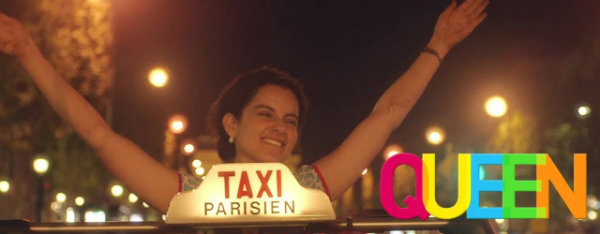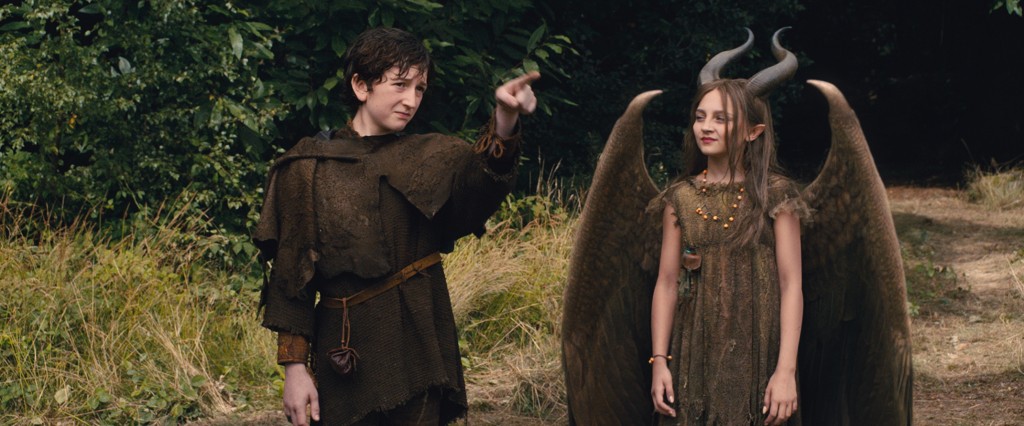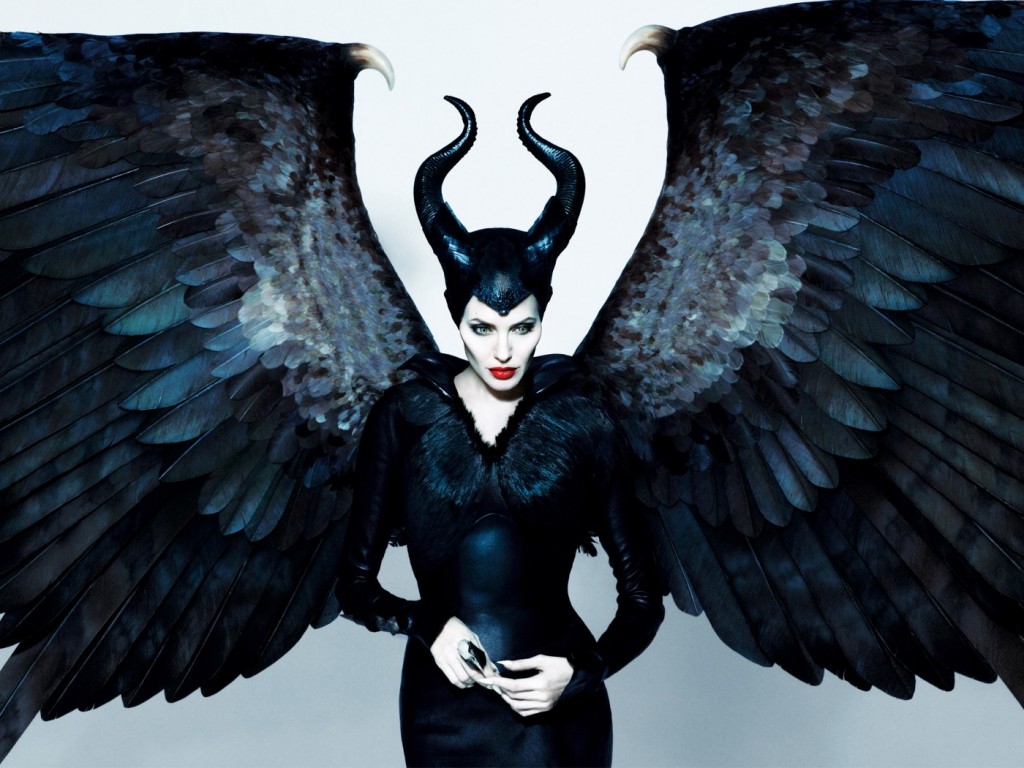Guest post by Nandini Rathi.

If you have courage to do something unconventional (like going solo on your honeymoon, not to mention to far-away, unknown cities) in spite of a heavy heart, there has to be hope. Queen (2014) is a gift to every girl who thinks she can be one. I love this film. I can watch parts of it again and again, smiling and laughing. The soundtrack happens to be just about the perfect accompaniment. Queen is the story of Rani Mehra (Kangana Ranaut), a sweet and submissive girl from Delhi who is on the verge of getting married. But Vijay, her long-term-boyfriend turned fiancé, calls it off two days before the big day – after all the extensive arrangements have been made and paid for by the bride’s family. After his stint at London, Vijay is convinced that he can do much better for a wife than the naive and simple Rani. (Rani also doesn’t have a great fashion sense in the beginning which classifies her as “un-modern.”)
Although shaken and heartbroken, Rani precariously decides to go alone on her once eagerly planned, much-awaited honeymoon to Paris and Amsterdam. This is an unconventional step for her (or for anyone in her place) and especially her protective family, who have diligently sheltered her from the unknown all her life. But you can get this gist from the trailer and the first ten minutes into the film. The adventure awaits.
From her solo travel to the two gorgeous cities, Rani is not so much “magically” transformed. She is the same person, albeit now adorned with a smile and a quiet self-confidence. In the end, she is just better equipped to deal with anything. This is a milestone film for Bollywood and Indian cinema in general. In this character-driven film, Rani is pretty, but she stands out much more because of her inner beauty, honesty and spirit of life – and this progressive film happened in Bollywood.
There are so many things about the film that make my heart sing, such as watching the main heroine dance bad-ass for herself (in the age of Bollywood numbers that directly cater to the male gaze). Kudos to director Vikas Bahl for paying attention to minute details in creating such moments. The best thing I find about Rani’s character is how broad-mindedly she accepts people who are different from her. She genuinely appreciates people for who they are and this inspires her to find herself. Rani just knows to live and let live.
In Paris, she meets and befriends Vijaylaxmi, the fun-loving, bed-hopping, hotel staff member of French-Spanish-Indian ethnic mix. In Amsterdam, she meets Oleksander, Taka, and Tim, her gang of roommates and partners in adventure. She also meets a fellow South Asian, Roxette, a pole dancer – stripper in the Red Light district. Rani’s interactions with all of these people are nothing short of breathtaking. It is the likeability of her character and the candid conversations (co-written by Ranaut herself) which urge the audience (especially the more conservative audience of India) to keep their biases away, at least temporarily.
From Lisa Haydon as Vijaylaxmi to Chinmaya Agrawal as Rani’s kid brother, Chintu, the supporting actors in Queen have been perfectly cast. As for Kangana Ranaut, she has proved her brilliance and malleability as an actress by playing Rani, who is a fresh change from her heretofore urban and edgy characters. To borrow from film critic Anupama Chopra’s perspective, even though in her eight-year-old film career Ranaut had shown remarkable talent, it hadn’t been easy to love her dark and volatile characters. That is, until Queen.
Had Vijay married Rani, she would have never realized how capable she is – of taking care of herself, of befriending fun people regardless of language, race or nationality, of being a natural entrepreneur (cooking and selling gol gappas in Amsterdam) and of being a spontaneous bad-ass in unexpected situations e.g. defending her purse from an aggressive pickpocket, and having a “lip-to-lip” kiss with the dishy Italian restaurateur to prove that Indians are better kissers.

Her newfound friends in Paris and Amsterdam would fondly remember her as “Queen,” which is what, as she tells them, her name means. Originally, it was Vijay who fondly called her that while trying to woo her. By the end of the trip, Rani has indeed claimed the invisible crown of her namesake. She breaks it off with Vijay in the most affectionate way, and with a genuine “Thank you.” If it wasn’t for his stupidity, her life would have been a completely different story.
The other day I was thinking what is it about the movie that especially resonates with me. As a quote lover, I saw a few well-dramatized one liners:
Don’t judge a person by their outfit:
There can be a broad-minded, caring, and conscientious soul within. Vijay lets Rani go because she seems too “behenji” for his new status. “Behenji” is a mild slur for an unfashionable, not-hip, young woman. Rani is hella brave and just needed to breathe in free air to find and become herself.
This only sets her in contrast with Vijay’s double standards. He’s the kind of guy who drinks and yet yells at his girlfriend for having sipped on celebratory champagne. The guy who on the forehand wants a modern and fashionable partner and on the backhand, freaks out over normal things she does for pleasure (like dancing in public in a group of girls), if it doesn’t fit the bill of what he and his parents would expect from the would-be wife/daughter-in-law. He wants an independent-looking girl (from her selection of clothes and make up maybe) but not one who actually has a mind of her own or wants to do something worthwhile with her life.
Nah, everyone deserves to feel free and dance like this with friends!
Grandmas are Rockstars:
This reminds me of other insightful and progressive Bollywood grandmas like in Pardes (Ghai, 1997) and Vicky Donor (Sircar, 2012). Rani’s grandmother can see the big picture when the rest are lost. She encourages Rani to chuck any regrets or worries, and believe that the loss of Vijay happened for the better. She even asks her to get out there and meet a gora munda (implied as “white hottie”) in Europe.
Recognize and call out the Hypocrisy:
Love this.

“You left without telling us. We were so worried.”
“But you didn’t call even once”
When Vijay meets Rani to get her back, at the cafe in Amsterdam, he claims that he needed to protect her from her friends who he refers to as “weird foreigners,” who he supposedly knows better. Rani has a staggering moment of disenchantment. Especially all this after Rani has had flashbacks of the times Vijay’s patronization had suffocated her.
Who doesn’t want to run happy like that in a gorgeous city (realizing they are actually over a long term, controlling ex)?
Travel for its “crazy” and “wow” moments:
Knowing that there are ways of living different than one’s own, and that it’s possible to share stories and adventures with all kinds of people that one never expected to meet — that’s some magic!
And for the homecoming:
Seeing the beautiful world beyond your own doesn’t result in loving home less. At the end of her journey, Rani is the same girl who is deeply attached to family and exceedingly happy to reunite with them. Even her family acknowledges that they can’t and need not always cocoon her.
Rani hasn’t become flashy just because of the trip “abroad.” She shares a laugh with her mother while recounting that the kurta she got in Amsterdam turned out to be “made in India.” Even when she imbibes a slightly different wardrobe, it happens like a shot of added diversity, a natural “mix ‘n’ match.” It is just cute to see Vijaylaxmi donning on her (Rani’s) kurti at the train station. One doesn’t have to wave a magic wand and discard a former version of oneself in order to evolve for the better.
Rani is still a sweet and soft-spoken woman, who, as Chopra puts it, has grown a smile and a spine. A queen complete with pride and dignity. See the invisible crown?
Nandini Rathi is a recent graduate from Whitman College in Film and Media Studies and Politics. She loves traveling, pop culture, photography, and adventures. She wants to be immersed in filmmaking, journalism, writing and nonprofit work to ultimately be able to contribute her bit toward making the world a better place. She blogs at brightchicdreams.wordpress.com












